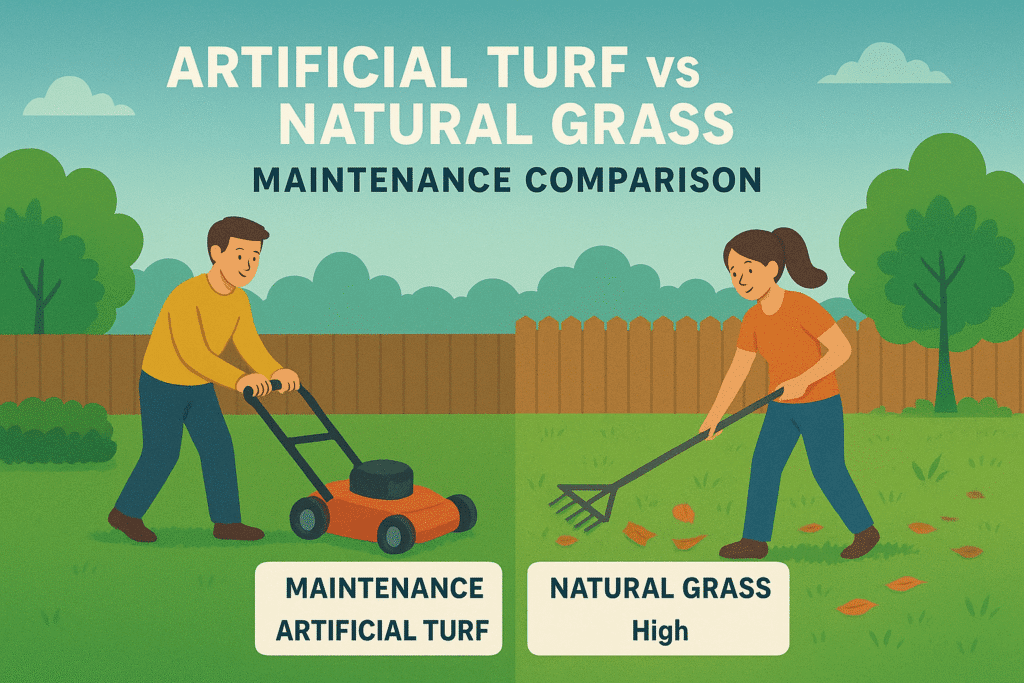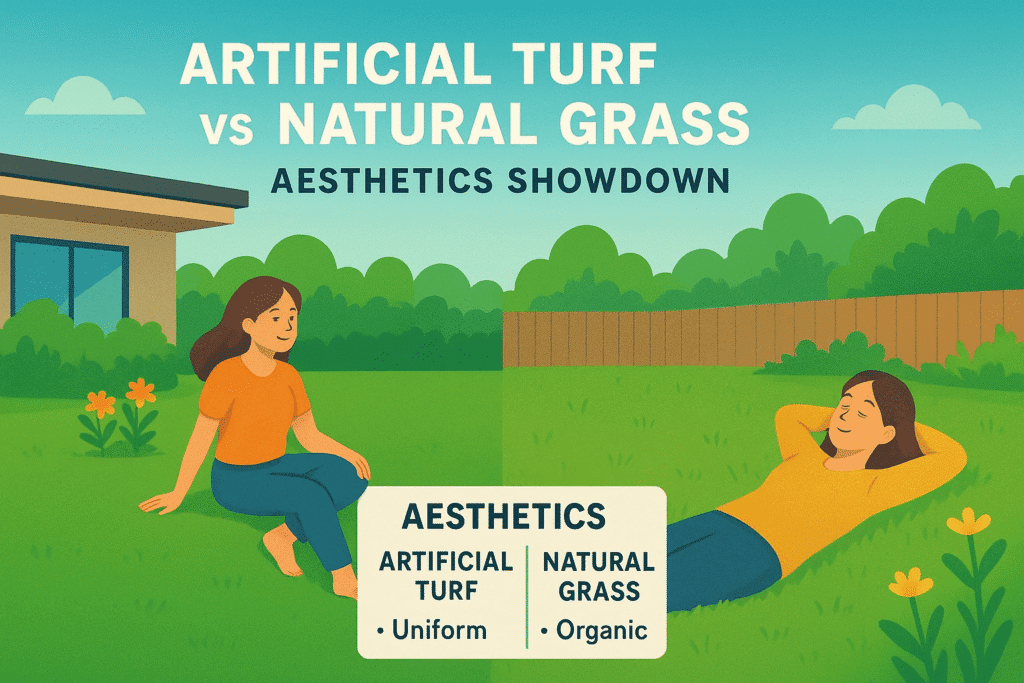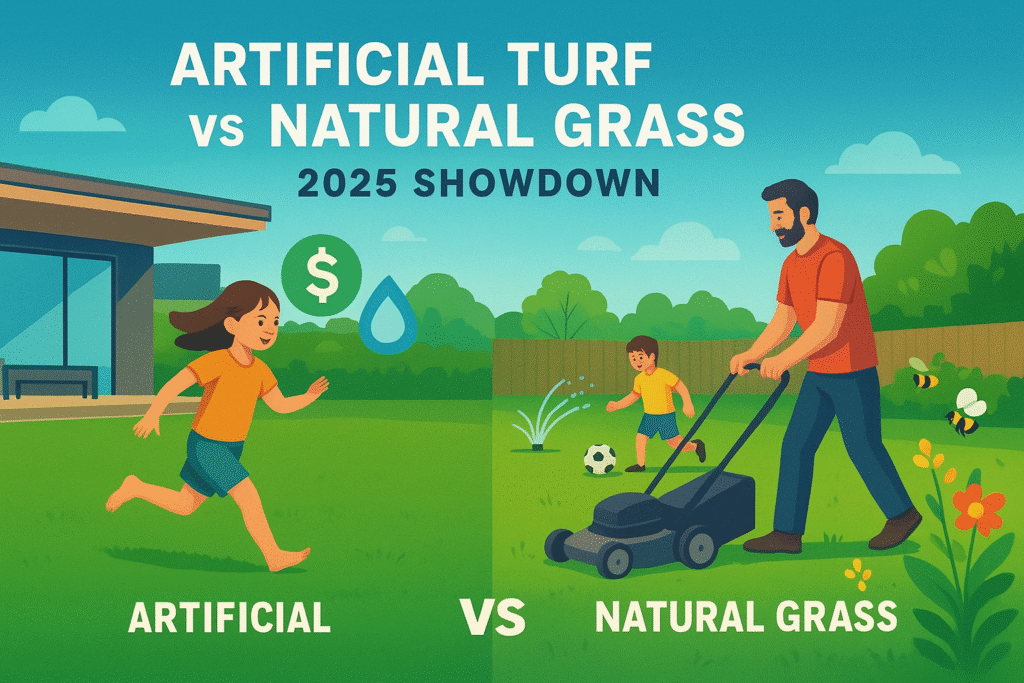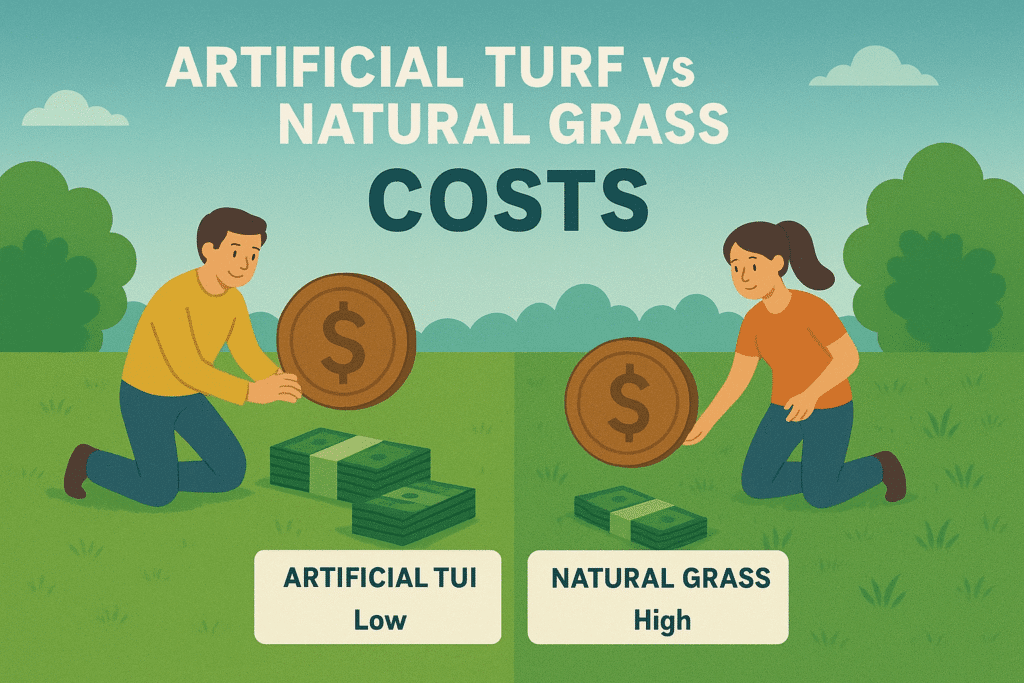
Table of Contents
ToggleArtificial turf vs natural grass: which one is better ?
Imagine you move into your yard on a hot summer afternoon. One neighbour has a perfectly green and low-maintenance artificial lawn while another has to water, trim and fertilize real grass every week to keep it alive. Both lawns look inviting but behind the surface they have very different stories about cost, efforts and impact on the environment.
In 2025, the debate between artificial turf vs natural grass has become more relevant. Cities that are facing drought restrictions are urging homeowners to conserve every drop of water and eco-conscious families are rethinking the footprint of plastic-based turf. Homeowners aren’t just choosing a lawn for looks, they’re making a long-term decision about how they want to spend weekends and what they want their bills to look like.
Artificial turf promises convenience which means no mowing, no mud and minimal upkeep. However, natural grass offers living benefits like cooling the air, supporting pollinators and giving that classic soft & earthy feel underfoot. Each comes with trade-offs and neither of them is a one-size-fits-all answer.
This guide will dive into every angle like appearance, maintenance, durability, cost, health and sustainability. In this way you can decide which lawn truly fits your lifestyle in today’s changing climate. At the end, you will see that the “perfect lawn” isn’t about following trends but about aligning your yard with your values and daily reality.

Environmental and Health impacts
A lawn is more than just decoration, it’s a part of your home’s micro ecosystem. Choosing between artificial turf and natural grass in 2025 means weighing big picture impacts on the planet and your health. Artificial turf saves water up to 100,000 gallons annually for a medium-sized yard which makes it appealing in drought-prone regions.
It also eliminates pesticides and fertilizer runoff which often pollutes local waterways. But turf isn’t impact-free. Over time, these fibres can shed microplastics and older infill types may leach chemicals. Heat absorption is another concern: turf surfaces can get 20-30°F hotter than grass under direct sun. Yet newer PFAS-free cooling-infused products reduce this effect.
Meanwhile, natural grass acts as a living carbon sink. It produces oxygen, absorbs CO² and naturally cools the surrounding air through transpiration. Grass also supports biodiversity including pollinators to soil microbes. But as we know it requires heavy maintenance – frequent watering, fertilizers, and mowing equipment all of which leave an environmental footprint.
For many people, grass polling can trigger allergies while turf offers a low-pollen and mud-free play surface. In short turf leads in water savings and allergy relief while grass shines in biodiversity and cooling. The greener choice depends on you, whether your priority is resource conservation or living ecosystem benefits.
Appearance and User Experience
When it comes to lawns, looks and feel matter same as costs or upkeep. After all, your yard is the first thing that people notice and it’s where you relax, play and spend quality time. So how do artificial turf and natural grass stack up in 2025 when it comes to appearance and everyday experience ?
Artificial turf has come a long way from the shiny & stiff carpets of the past. Modern versions use multi-tone polyethylene blades which are stitched at varying angles to mimic uneven shades of real grass. Some high-end brands even use AI-designed fibers that sway lightly with the wind to create a surprising natural effect. Turf also stays emerald green year-round with no half patches, no mud puddles and no seasonal browning. This is the biggest selling point for many homeowners.
However, natural grass still has a charm that a synthetic alternative can’t fully copy. That cool & dewy crunch under bare feet on a summer morning, earthy smell after rain or the gentle sway of blades in the breeze — all these sensory experiences are heart-warming. And also, grass naturally cools the area around it by several degrees which makes play zones and patios more comfortable during heatwaves.
So in short, turf wins for uniformity and convenience while grass wins for authenticity and sensory richness. The right choice depends on whether you value low-effort perfection or real-life sensory experiences. According to a 2023 report by Western Resource Advocates, a full-sized natural grass field (~1.32 acres) may require up to 1.5 million gallons of water per year just for irrigation which depends on location too.

Artificial turf vs natural grass: Maintenance Demand
One of the biggest factors that all homeowners notice when they’re choosing artificial turf or natural grass is how much time and effort it actually takes to keep the yard looking good. Artificial turf is low-maintenance for a lawn. There’s no mowing, edging or fertilization, it just needs an occasional rinse with a hose to clear dust or pet mess.
A quick brush can keep blades upright and that’s all. On average, turf owners spend under five hours a year on upkeep. This hands-off approach is a huge relief for busy families. On the other hand, natural grass is a living system that needs care. The maintenance includes- weekly mowing, seasonal fertilizing, aeration, weeding, pest control and regular watering. Together that easily adds up to 40-50 hours of work every year. Remember that I haven’t mentioned the ongoing costs of fuel, fertilizers and garden tools yet.
For pet owners natural grass struggles under heavy use and often turns patchy or yellow in spots. If you want your weekends free and a yard that looks neat with minimal effort then turf is a good choice. But if you find satisfaction in the ritual of mowing and nurturing a living landscape then natural grass takes the crown.
Durability and longevity
Lawns aren’t just to look pretty they take a beating from kids, pets, sports and everyday traffic. That’s where durability becomes a deciding factor in the artificial turf vs natural grass debate. Artificial turf is built to endure. Premium 2025 models use UV-resistant polyethylene fibers with reinforced backing that is designed to handle 500,000+ footsteps without fading or flattening. Warranties now stretch up to 20 years which makes turf a long-term investment.
Pets including household also find turf holds up well- urine rinses away and no digging paws can ruin the surface. In contrast, natural grass is resilient but vulnerable. Heavy foot traffic compacts the soil, thin patches and often requires reseeding or fresh sod each year. Grass also struggles during droughts or extreme heat. At last they turned brown and brittle without consistent care.
However the advantage is regeneration- grass can heal and grow back over time if it’s properly managed. Turf wins on long-term durability especially for high-use areas while grass is better suited for low-traffic yards where natural regrowth can keep it looking fresh.

Cost breakdown
Money often tips the scales when we choose between artificial turf and natural grass. The cost isn’t just about installation- it’s about what you will keep spending or saving over the years. Artificial turf has a steep upfront investment. For a standard 1,500 sq. ft. yard, installation in 2025 averages $10,000–$15,000 which depends on quality and base prep.
Maybe those price tag feels heavy but here’s the catch- once they’re installed, turf needs almost no ongoing expenses. No mowing, no watering and no fertilizers – just an occasional rinse and minor repairs. Over 10 years these turf typically saves around $6,000–$8,000 compared to grass. In water-stressed regions like California, rebates and tax credits can also offset initial costs.
Natural grass seems cheaper at first. The initial cost for the same yard may be around $3,000–$4,000 but maintaining it adds up more expenses. Water bills, lawn equipment, fertilizers, pesticides and reseeding, if all are included then it can push the total costs above $20,000.
| Expense Type | Artificial Turf (10 Years) | Natural Grass (10 Years) | Savings |
|---|---|---|---|
| Installation | $12,000 | $4,000 | — |
| Water & Fertilizer | $500 | $10,000 | $9,500 |
| Repairs & Tools | $1,000 | $6,000 | $5,000 |
| Total (10 Years) | $13,500 | $20,000 | $6,500 |
Artificial Turf vs natural grass: which is best for you?
Both have different purposes and that’s why the best choice between artificial turf and natural grass depends on how you plan to use your space. Artificial turf is ideal for urban backyards, rental properties or family play zones where shade or poor soil makes grass hard to maintain. It’s also pet owners’ favourite because urine rinses away and muddy paw prints disappear.
Sports facilities and businesses also lean thanks to its durability, consistent surface and ability to handle year-round use without downtime. However, natural grass works best for people who value a living landscape. It’s perfect if you enjoy gardening and want to grow food alongside your lawn. The cooling effect of greenery in a hot summer is also beneficial for you.
A growing trend in 2025 is the hybrid approach which combines turf in high-traffic areas with drought-tolerant grass. This mix offers durability without sacrificing nature’s benefits. In my personal opinion you should always choose based on your lifestyle.
FAQs
Is artificial turf cheaper than natural grass in the long run?
Yes. Artificial turf has a higher upfront installation cost and it usually pays for itself within 5-7 years with minimal upkeep and near-zero water bills. Homeowners often save $6,000–$8,000 over a decade compared to maintaining natural grass.
Which is better for the environment – artificial turf vs natural grass?
Both have their pros and cons. Artificial turf conserves large amounts of water and avoids pesticide runoff but it can contribute to microplastics pollution and heat buildup. Natural grass supports biodiversity, produces oxygen and cools the air but it requires heavy watering and chemical inputs in many regions.
Does artificial turf feel realistic compared to real grass?
Modern turf is designed with multi-tone fibers and cushioned infills to look and feel like natural grass. Many premium options even sway with the wind. However, it can’t fully replicate the natural cooling Effects of grass and fresh scent after rain.
